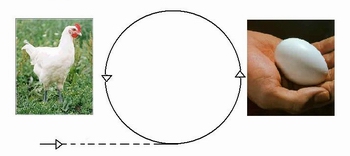| Hypercommunication - Crash Courses - Second-order Systems Theory [ Hyper-Library ] [ Hyper-Lexicon ] [ back ] |
|
|
backward - Page 10 - forward |
|
My argumentation is circular: I regard a system as the construction of an observer and the observer as a system. So in this respect there can be neither a plausible beginning nor a plausible structure for the argumentation. As a reader I can start somewhere anyway, because I can open any book where I want (table of contents). In a circular argumentation, it doesn't matter where I start, sooner or later I have to come to the point where every beginning is kept. Logically, the entry into a circular argumentation always makes conditions, which later appear as consequences of the argumentation. In everyday life, under these circumstances, I speak of an egg-chicken problem, to express that I cannot see a constructive problem in it. I can well accept that chickens come from eggs and lay eggs. But when I have to tell the story, I naturally have the problem of the beginning: Which was first, the chicken or the egg? Or even, which do I tell first? |
|

|
Since I generally regard systems - in the sense of Radical Constructivism - as constructions, I begin genetically logically with actual constructions. So I will first explain what I call a construction. But before that, I will of course say in more detail, in which situations I make constructions at all and why. So I will start the presentation of systems theory with quite practical, everyday situations of construction, i.e. with problems for which I am looking for constructive (actual) solutions.
I call a problem a perceived task that I cannot solve without further ado, but which has a solution. Every problem is the problem of an observer. If I recognize a problem, I am the observer of the problem. As an observer I have the possibility to concentrate on the problem and to look for a solution. But I can also ask myself why this problem is a problem at all, or why it is specifically my problem. And of course I can also ask myself how I have to be constructed myself in order to perceive the problem at all. In the first case I act like a constructor. In the second case I behave like an actual observer who, for whatever reason, does not perceive a problem, or who realizes that the problem is a consequence of perception. In the third case I make a second order observation, because I no longer observe the observed problem, but the observer who has the problem.
So my story has two intertwined beginnings: the actual beginning is cybernetic technology, but I start with the observer who "observes" this technology, that is, develops and uses it.
So I start the presentation of systems theory by explaining what kind of problems I solve "systems-theoretically". In my circular argumentation I will then use my solution method to show what I call system theory and to what extent my solution method is system theoretical. I will proceed quasi historically by tracing a certain development of systems theory, which N. Wiener based his novel on the development of cybernetics. In a sense, it is a history of technology in which a formal description of machines is generalized in such a way that it can be used to clarify any phenomena. Cybernetic system theory was developed on the basis of automata, but it does not describe automata, but procedures or modes of operation represented by automata (note 1).
And of course the crash course also consists of many instructions!
Here is the first instruction:
|
Become aware - linguistically and figuratively - of how you envision a "system". |
|
There are any number of images and formulations that somehow fit. The main thing here is to become aware of your own formulations and images.
|
|
Implementation:
|
|
In examples the extension of the term (a possible meaning) is expressed. Examples are illustrative, but of course I have to say where they illustrate the intention of the term (what is meant). |
|
Examples:
|
|
Cybernetics represents the last stage of technology for the time being, namely programming, i.e. the description of processes. My systems theory serves to sound out the cybernetic terminology. I do not believe that technological terms can be used to describe "the" human being or "life". I make myself aware of what I can meaningfully describe. Social projects such as "artificial intelligence" or "genetic manipulation" can probably be seen as attempts to understand the nature of man. I prefer to understand these projects as problem shifts: surely, naively, one would like to know what life is. If, instead of a portrait, a reflection of the explanation comes out, we have perhaps gained more than we can anticipate. The Bible says: You will not make an image for yourself. This could become true if we start with naïve needs like the famous Swiss scientist Frankenstein (note 2).
|
|
backward - Page 10 - forward |